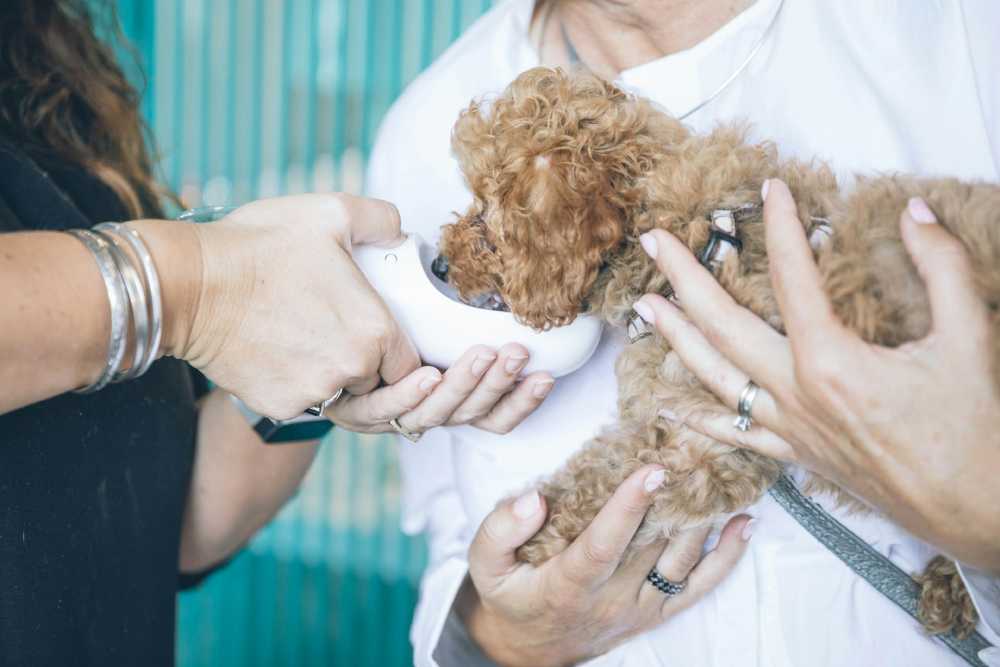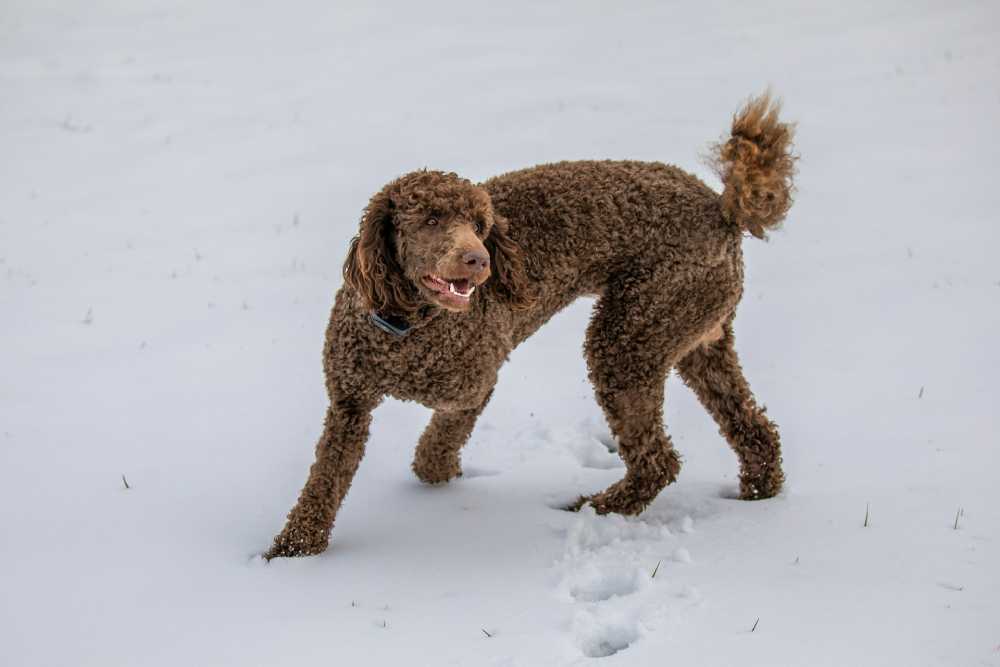Standard Poodle Life Expectancy
Some dog breeds live longer than others based on a variety of factors. The Standard Poodle life expectancy is between 12-15 years on average, which is longer than most large-breed dogs. I’ve treated hundreds of these intelligent canines as a veterinarian, and their impressive lifespan continues to amaze both medical professionals and pet owners.
A Standard Poodle’s lifespan depends on genetics and daily care choices. Many owners want to know how long their beloved pets will live and what they can do to help them thrive. This piece dives into the factors that shape a Standard Poodle’s life and offers practical ways to add healthy years to their life.
What you’ll discover:
- Genetic factors that affect your Standard Poodle’s lifespan
- Common health issues and how to prevent them
- Health screenings and preventive care basics
- Diet and exercise guidelines
- Tips to care for your aging Poodle
Contents
- 1 About Standard Poodle Genetics and Longevity
- 2 Common Health Conditions Affecting Lifespan
- 3 Essential Health Screenings and Prevention
- 4 Nutrition and Exercise for Longevity
- 5 Managing Senior Standard Poodle Health
- 6 Standard Poodle Life Expectancy Frequency Asked Questions
- 6.1 Is 10 old for a Standard Poodle?
- 6.2 Can Poodles live up to 20 years?
- 6.3 What age do Standard Poodles slow down?
- 6.4 What age is senior for Standard Poodles?
- 6.5 What is the average death age of a Standard Poodle?
- 6.6 What happens to Poodles as they get older?
- 6.7 How long do Standard Poodles live indoors?
- 6.8 What is the mental age of a Poodle?
About Standard Poodle Genetics and Longevity
The genetic makeup of Standard Poodles is a vital part of their health and longevity. My extensive work as a veterinarian studying canine genetics has shown how genetic diversity can substantially affect these elegant dogs’ life expectancy.
Genetic factors affecting lifespan
Standard Poodles have about 100,000 genes across 39 chromosome pairs. This creates a complex genetic blueprint that shapes their health and longevity. Their lifespan depends on several genetic factors:
- Inherited health conditions
- Genetic diversity levels
- DNA mutation accumulation
- Breed-specific genetic traits
Impact of inbreeding coefficients
The Coefficient of Inbreeding (COI) relates directly to Standard Poodle longevity. Research reveals that each 1% increase in inbreeding reduces a dog’s lifespan by about 20.6 days. The least inbred Poodles live 4 years longer than highly inbred ones – a remarkable difference.
Recent breeding practices have created concerning trends in genetic diversity. Studies show that 30% of the breed population carries 70% of the genetic diversity in Standard Poodles. This imbalance comes from historical breeding practices, especially the mid-20th century bottleneck that created severe breed-wide genetic limitations.
Role of size in life expectancy
Size shapes Standard Poodle longevity in important ways. These dogs, being the largest Poodle variety, typically live 12-15 years. This lifespan is shorter than their smaller counterparts. Research shows larger dogs face higher risks of certain health conditions, particularly cancer.
Size and longevity share a complex relationship that both genetic and environmental factors influence. Cancer mortality rises with body size in purebred dogs. This fact matters especially for Standard Poodles compared to smaller variants.

Mixed-breed dogs live about 1.2 years longer than purebred dogs of similar size. This finding highlights genetic diversity’s importance in longevity. Breeders now work to develop strategies that encourage genetic diversity while preserving Standard Poodles’ beloved traits.
Common Health Conditions Affecting Lifespan
Standard Poodles need proper care to live longer, healthier lives. My experience as a veterinarian treating numerous Standard Poodles has shown me how specific health issues can affect their lifespan.
Cancer risks and prevention
Cancer remains the leading cause of death in older Standard Poodles. Dark-colored Standard Poodles have a higher risk of specific cancers, especially squamous cell carcinoma of the digit (SCDD). Light-colored Poodles rarely show signs of this condition.
Key prevention strategies include:
- Regular screening and early detection
- Maintaining healthy weight
- Limiting exposure to environmental toxins like pesticides and herbicides
Cardiovascular health concerns
Standard Poodles often develop dilated cardiomyopathy (DCM), a life-threatening heart condition that weakens and enlarges their heart. Atrial septal defect (ASD), a congenital heart malformation, runs in families and poses another risk.
Warning Signs of Heart Issues:
- Weakness or tiredness
- Labored breathing
- Coughing
- Potential collapse in severe cases
Dogs need annual electrical heart screening (ECG) and echocardiogram starting at age one to detect problems early.
Gastrointestinal issues including bloat
Standard Poodles’ deep chest structure makes them vulnerable to bloat, or Gastric Dilatation-Volvulus (GDV). This condition can turn fatal within hours without treatment. Even with surgery, the mortality rate reaches 20%.
Critical bloat symptoms to watch for:
- Distended abdomen
- Unsuccessful attempts to vomit
- Excessive drooling
- Restlessness and pacing
- Rapid breathing
Prevention strategies include:
- Offering smaller meals throughout the day instead of one large meal
- Limiting exercise immediately after eating
- Considering preventive gastropexy surgery
- Keeping food bowls at floor level
Owners must recognize symptoms and seek veterinary care immediately. Bloat can become life-threatening within minutes to hours. Your Standard Poodle’s longevity depends on understanding and monitoring these health conditions.
Essential Health Screenings and Prevention
Health screening and prevention are the life-blood of extending your Standard Poodle’s life expectancy. Your dog can live longer when you monitor their health and detect issues early.
Recommended genetic testing
The Orthopedic Foundation for Animals (OFA) suggests specific genetic tests for Standard Poodles. These tests help identify health risks early:
- Hip Dysplasia evaluation from approved agencies
- Eye clearance through CAER (Companion Animal Eye Registry)
- Cardiac evaluation by board-certified specialists
- Sebaceous Adenitis (SA) screening
- Thyroid evaluation from approved laboratories
Age-appropriate health screenings
Standard Poodles need different health screenings throughout their life. Board-certified ophthalmologists should examine your dog’s eyes yearly until they recommend otherwise. Your dog’s heart health screening should start after their first year.
Key screening milestones:
- First detailed exam: 8 weeks
- Hip evaluation: 24+ months
- Cardiac screening: Annual after 12 months
- Eye examinations: Annual
- Thyroid testing: Between heat cycles for females, post-maturity for males
Vaccination and preventive care schedules
Vaccines fall into core and noncore categories, and their timing is significant for the best protection. Your dog needs core vaccines, while noncore vaccines depend on their lifestyle and location.
Core vaccination schedule:
- First vaccination: 6-8 weeks (DHP)
- Second vaccination: 9-11 weeks (DHP)
- Third vaccination: 12-15 weeks (DHP)
- Fourth vaccination: 16-20 weeks (DHP)
- Rabies: 3-6 months with boosters as required by law
Noncore vaccines might include Bordetella, Parainfluenza, and Canine Influenza. These are recommended especially when you have social dogs who visit day camps, dog parks, or boarding facilities. Your veterinarian should customize the vaccination schedule based on your dog’s needs and risk factors.
Regular dental care, including professional cleaning and home maintenance, works alongside these preventive measures. This integrated approach to health screening and prevention helps your Standard Poodle discover their full life expectancy potential.
Recommended: Labrador Retriever Life Expectancy: Owner’s Guide
Nutrition and Exercise for Longevity
A Standard Poodle’s life expectancy depends heavily on proper nutrition and regular exercise. My years as a veterinarian studying canine health have shown me how diet and activity work together to help these dogs live longer, healthier lives.
Age-specific dietary requirements
Standard Poodles need different nutrients as they age. Puppies should eat about 40-55 calories per pound daily. Adult dogs need 35-45 calories per pound. Older Poodles require around 40 calories per pound to stay at a healthy weight.
These nutrients are the foundations of optimal health:
- High-quality proteins to maintain muscles
- Healthy fats to keep coat and skin healthy
- Complex carbohydrates to provide steady energy
- Omega-3 fatty acids to support brain and joints
- Essential vitamins and minerals
An adult Standard Poodle eats up to 1,500 calories daily, based on activity level. Quality proteins should make up most of their diet. Sweet potatoes, green beans, and selected fruits complement their meals perfectly.
Exercise recommendations by life stage
Life Stage Daily Exercise Requirements Puppy (under 18 months) 5 minutes per month of age Adult (1-7 years) 60 minutes minimum Senior (7+ years) Modified but consistent activity Standard Poodles thrive on varied exercise routines that challenge both body and mind. Swimming works especially well because these dogs have waterproof coats and webbed paws that make them natural swimmers.
Weight management strategies
A Standard Poodle’s weight substantially affects their lifespan. Research shows lean dogs live 6 months to 2.5 years longer than overweight ones. Weight monitoring and portion control help manage weight effectively.
Experts suggest these weight control methods:
- Use proper measuring cups for food portions
- Add green beans and other healthy vegetables to meals
- Keep treats under 20% of daily calories
- Set regular feeding times
Regular vet visits help track puppy growth and adult weight. Adding water to dry food helps dogs feel full. Low-calorie vegetables provide nutrients without extra calories.
Related: Pitbull Life Expectancy: What Owners Should Know
Managing Senior Standard Poodle Health
Standard Poodles need extra attention as they enter their golden years around age 7. Their care requirements change and owners must adjust their routines to keep these distinguished companions healthy and comfortable.
Signs of aging to monitor
Your Standard Poodle will show several signs of aging that you should watch out for. The first signs often appear as gray fur around their muzzle and eyes. You’ll also notice changes in their behavior, like sleeping more and having less energy.
Look out for these changes:
- Cloudy eyes or trouble seeing things
- Different sleep patterns
- Less excitement about active play
- Joint stiffness and movement issues
- Changes in eating or drinking habits
- More barking or anxious behavior
Adapting care for senior needs
Your senior Standard Poodle’s daily care routine needs some tweaks. Many people think grooming becomes less important as dogs age. In stark comparison to this, regular grooming prevents skin infections, matting, and helps avoid anxiety or depression.
Physical Comfort Adaptations:
- Get orthopedic beds that support their joints
- Set up ramps or steps for easy furniture access
- Place food and water bowls higher to ease neck strain
Senior Poodles need special grooming care because their skin becomes more sensitive with age. These grooming sessions give you a chance to spot potential health issues like unusual lumps or skin problems early.
Quality of life assessment
The HHHHHMM Quality of Life Scale helps you assess your senior Standard Poodle’s wellbeing. This scale looks at seven vital areas: Hurt, Hunger, Hydration, Hygiene, Happiness, Mobility, and More good days than bad.
Quality Assessment Metrics:
- Watch their eating habits and frequency
- Keep track of how they move and handle exercise
- Notice changes in social behavior
- Keep a log of good versus tough days
Your senior Standard Poodle should visit the vet twice yearly. These check-ups catch age-related issues early and can help extend your dog’s life.

Brain health deserves special attention in aging Standard Poodles. Research shows 14% to 35% of dogs over eight years old develop canine cognitive dysfunction syndrome (CCDS). Watch for signs like confusion, irregular sleep patterns, and changes in how they interact with family.
A stable environment helps maintain your senior Standard Poodle’s quality of life. They feel more secure with regular routines and familiar surroundings, especially if their vision or hearing starts to fade. Light exercise keeps them mobile and mentally sharp, but remember to adjust activities based on their energy levels.
Standard Poodle Life Expectancy Frequency Asked Questions
What is the longest a Standard Poodle has lived?
The longest recorded lifespan for a Standard Poodle is 18 years. While this is exceptional, many Standard Poodles live to around 12 to 15 years with proper care. Genetics, diet, exercise, and overall health all play a role in their longevity.
Is 10 old for a Standard Poodle?
At 10 years old, a Standard Poodle is considered a senior dog, but it’s not necessarily “old.” Many Standard Poodles live well into their teens, so 10 is an age where they may start showing signs of aging, like slower movement or changes in energy. With the right care, they can still lead a happy, active life.
Can Poodles live up to 20 years?
While it is rare, some Poodles can live up to 20 years with excellent care. The average lifespan for a Standard Poodle is 12 to 15 years, but with a healthy diet, regular vet visits, and appropriate exercise, a few exceptional Poodles have been known to reach 20 years. Genetics play a significant role in longevity.
What age do Standard Poodles slow down?
Standard Poodles generally start to slow down around 7 to 8 years of age. As they age, they may become less energetic and may not be as playful as they were when they were younger. It’s important to adjust their exercise routine and ensure they are comfortable as they get older.
What age is senior for Standard Poodles?
A Standard Poodle is typically considered a senior at around 7 to 8 years old. Like many larger dog breeds, they age faster than smaller breeds. Senior Poodles may experience changes in energy levels, joint health, and sensory abilities, which is why regular veterinary care becomes even more important at this stage.
What is the average death age of a Standard Poodle?
The average death age for a Standard Poodle is around 12 to 15 years. However, this can vary based on factors like genetics, health, diet, and lifestyle. Poodles that receive excellent care and have fewer genetic predispositions to health issues may live longer.
What happens to Poodles as they get older?
As Poodles get older, they may experience physical changes such as reduced energy, joint stiffness, and potential weight gain. They may also develop health issues like arthritis, dental problems, or vision loss. Mentally, they may become less active but still enjoy companionship and mental stimulation. Regular checkups and maintaining their overall health are essential.
How long do Standard Poodles live indoors?
Standard Poodles, like most dogs, can live indoors for their entire lifespan as long as they get enough physical and mental exercise. They tend to do well in homes where they can receive attention, stimulation, and regular walks. Their lifespan is not directly affected by whether they live indoors or outdoors, but their quality of life is greatly enhanced by a loving, active environment.
What is the mental age of a Poodle?
A Poodle’s mental age is influenced by both its individual personality and age. Poodles are known for being highly intelligent and can retain a “puppy-like” curiosity well into their senior years. As they age, they may slow down mentally and become less responsive to commands, but many Poodles maintain sharp minds, especially when provided with regular mental stimulation.

